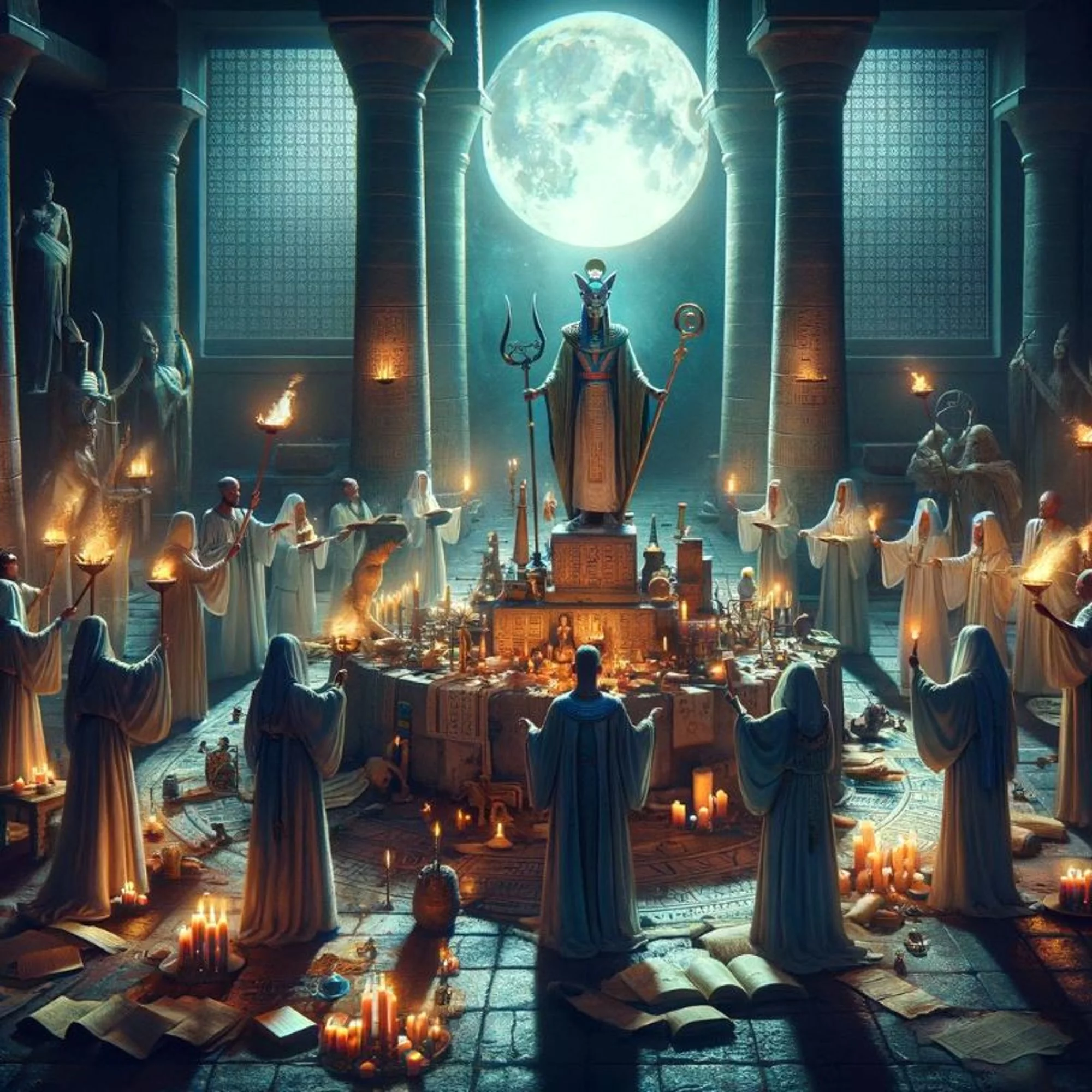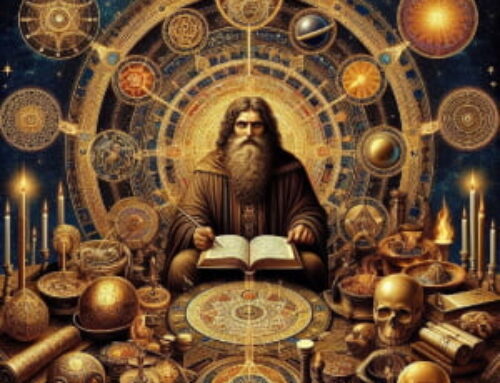Contents
- 1 Introduction
- 2 The Foundations of Hermetic Wisdom in Ancient Egypt
- 3 Sacred Rituals and Cosmic Alignments
- 4 Ancient Egypt occult: Mysteries of the Pyramids and Temples
- 5 Hieroglyphs and Sacred Symbols
- 6 Initiation Rites and the Path to Enlightenment
- 7 Integrating Spirituality into Daily Life
- 8 Conclusion
- 9 FAQ – Ancient Egypt Occult
- 9.1 1. What defines Ancient Egypt Occult practices?
- 9.2 2. How were Ancient Egypt Occult beliefs manifested in daily life?
- 9.3 3. What significance did pyramids and occult temples hold in Ancient Egypt?
- 9.4 4. Can you explain the role of hieroglyphs in Ancient Egypt Occult practices?
- 9.5 5. What were initiation rites like in the Ancient Egypt Occult system?
- 10 References:
Introduction
From the majestic pyramids that stretch towards the heavens to the cryptic hieroglyphs that adorn temple walls, each stone and symbol in ancient Egypt occult ´s testament to a civilization deeply embedded in the mysteries of the occult. These were not mere monuments of stone, but conduits of spiritual power and wisdom, guiding souls towards enlightenment through the veil of the material world. The priests and priestesses of this ancient land were not just intermediaries between the gods and mankind but keepers of an arcane knowledge that promised to unlock the mysteries of existence itself.

As we delve into the heart of ancient Egypt occult practices, we encounter a world where rituals, symbols, and the alignments of stars were not mere observances but keys to unlocking the mysteries of existence and the soul’s journey. The pyramids and temples, majestic and silent, stand as testaments to this deep spiritual science, each stone a symbol of the quest for enlightenment. Through the intricate hieroglyphs, the ancient Egyptians communicated their understanding of the universe, offering us glimpses into their profound connection with the divine.
This article, drawn from the essence of ancient texts and rituals, invites you on a journey to explore the sacred mysteries of the Nile. As we traverse through the subtopics, we aim to reconstruct the spiritual landscape of ancient Egypt, shedding light on the hermetic principles that shaped its culture, the rituals that defined its religious practices, and the architectural marvels that continue to fascinate. Join us as we explore the ancient Egypt occult, where every symbol tells a story of spiritual pursuit, and every ritual brings us closer to the divine.
The Foundations of Hermetic Wisdom in Ancient Egypt
Origins and Core Principles
In the heart of ancient Egypt occult culture lay the seeds of Hermetic wisdom, a profound spiritual philosophy attributed to the deity Thoth, revered as the god of writing, magic, and wisdom. This wisdom, deeply entwined with the fabric of ancient egypt occult culture, guided the ancient Egyptians in their daily lives and their understanding of the cosmos. The principles of Hermeticism, rooted in the writings known as the Hermetica, encapsulated teachings on the nature of the universe, the interconnectivity of all things, and the pursuit of gnosis – the knowledge of the divine.
Ancient Egypt occult texts and artifacts, as unearthed by scholars and preserved in the annals of history, bear testament to the profound impact of these teachings (e.g. 1). The Hermetic tradition posited that the macrocosm and microcosm were reflections of each other, a belief that influenced not only spiritual and religious practices but also the societal and architectural achievements of ancient Egypt.
Hermeticism and the Quest for Gnosis
The quest for Gnosis in ancient Egypt occultism was not merely an intellectual exercise but a deeply spiritual practice. Hermetic wisdom taught that through understanding the laws of the universe, one could achieve a state of harmony with the cosmos, leading to spiritual enlightenment and the realization of one’s divine nature. This pursuit was mirrored in the meticulous design of temples and pyramids, constructed in alignment with celestial bodies, serving as earthly gateways to the divine.
The teachings emphasized the importance of inner transformation, a process facilitated through rituals, meditative practices, and the decoding of sacred symbols. These practices were designed to awaken the soul to its higher purpose, guiding it through the trials of earthly existence towards the ultimate reunion with the divine source.
The Legacy of Thoth-Hermes
The legacy of Thoth-Hermes transcends the boundaries of time and geography, influencing not only subsequent Egyptian generations but also the spiritual and philosophical currents of Greek, Roman, and Renaissance thought. The figure of Hermes Trismegistus, as he came to be known in later traditions, symbolizes the synthesis of Egyptian wisdom with Greek philosophical inquiry, embodying the universal quest for knowledge and understanding.
The Hermetic principles of correspondence, vibration, and rhythm, among others, have permeated various mystical traditions, offering a timeless wisdom that continues to inspire seekers of spiritual truth. The impact of these teachings is evident in the continued fascination with Ancient Egypt occult culture, its mysteries, and its unparalleled contributions to the history of human spirituality.
Sacred Rituals and Cosmic Alignments
Unveiling the Mystical Rites
The fabric of ancient Egyptian occultism was woven with intricate rituals designed to bridge the earthly realm with the divine cosmos. These ceremonies, deeply rooted in the Hermetic tradition, were not mere acts of faith but profound engagements with the vibrational energies of the universe. The rituals performed within the sacred spaces of temples were complex, involving chants, offerings, and symbolic acts that mirrored celestial patterns, facilitating a harmonious flow of cosmic energy.
The significance of these rituals lay in their ability to align human consciousness with the divine order, thereby transforming the participants and allowing them to access higher states of awareness. Through this sacred communion, the Egyptians sought to understand the deeper mysteries of life and death, creation, and the eternal cycle of the cosmos.
The Architectural Harmony with the Heavens
Ancient Egyptian pyramids and temples were marvels of architectural genius, designed not just for their durability and aesthetic appeal but as living embodiments of spiritual principles. These structures were meticulously aligned with the stars, planets, and celestial events, serving as physical anchors for the cosmic energies they sought to harness.
This architectural harmony with the heavens was a testament to the Egyptians’ profound understanding of the universe’s rhythms and their desire to integrate these into their spiritual practices. The positioning of the Great Pyramids of Giza, for instance, in relation to the Orion constellation, exemplifies the Egyptians’ aspiration to mirror the celestial in the terrestrial, creating sacred spaces that were gateways to the divine.
The Role of the Priesthood in Cosmic Integration
The Ancient Egypt occult priesthood played a crucial role in maintaining the cosmic order through their execution of sacred rituals (3). Trained in the esoteric arts and the mysteries of the Hermetic wisdom, these priests and priestesses acted as intermediaries between the gods and the people, ensuring that the divine energies were rightly channeled and harmonized with earthly existence.
Their deep knowledge of astrology, astronomy, and the sacred sciences enabled them to conduct rituals that aligned with specific cosmic events, imbuing these ceremonies with a powerful resonance. Through their dedication and understanding, the priesthood ensured that Egypt remained in sync with the cosmic order, celebrating the unity of all existence.
Ancient Egypt occult: Mysteries of the Pyramids and Temples
Spiritual Significance of Egypt’s Sacred Structures
The pyramids and temples of ancient Egypt occult culture stand as enduring symbols of the civilization’s profound spiritual and mystical knowledge. These architectural masterpieces were not merely tombs or places of worship but encoded repositories of ancient wisdom, designed in harmony with cosmic laws. Each structure was a microcosm of the universe, reflecting the Egyptians’ belief in the interconnectedness of the cosmos and the earthly realm.
Architectural Alchemy and Celestial Alignment
The construction of these sacred sites was a form of architectural alchemy, a deliberate effort to blend earthly materials with divine principles. The precise alignment of the pyramids with the stars, particularly the Orion constellation, reveals a sophisticated understanding of astronomy and its spiritual implications. This celestial alignment was believed to facilitate the pharaohs’ ascension to the afterlife, mirroring the soul’s journey back to the stars from which it came.
Temples as Portals to the Divine
The temples of ancient Egypt occultism were portals to the divine, serving as the physical and spiritual junction points between the gods and humanity. Each temple was dedicated to a specific deity, designed to embody the characteristics and energies of that god or goddess. The intricate reliefs and hieroglyphs adorning the temple walls were not mere decorations but sacred texts that conveyed esoteric knowledge to those initiated into the mysteries.
The inner sanctuaries of these temples were sites of profound mystical experiences and initiations, where priests and initiates could commune directly with the divine. The rituals conducted within these spaces were designed to awaken higher consciousness and facilitate spiritual transformation, embodying the essence of the Hermetic wisdom that underpinned Egyptian spirituality.
Hieroglyphs and Sacred Symbols
Decoding the Language of the Gods
Ancient Egyptian hieroglyphs, more than a mere script, were considered the language of the gods, imbued with magic and power. These sacred symbols served multiple functions: as a means of communication, a method for preserving knowledge, and a tool for interfacing with the divine. Each hieroglyph was not just a letter but a concept, a piece of the cosmic puzzle that, when properly understood and used, could invoke the energies it represented.
Symbols as Vessels of Esoteric Knowledge
Beyond their decorative and communicative roles, hieroglyphs and other sacred symbols found in temples, tombs, and texts held deep esoteric significance. They were keys to unlocking the mysteries of the universe, each symbol a codex of spiritual knowledge and principles. Initiates into the Ancient Egypt occult mysteries would spend years learning to decipher these symbols, which were believed to contain the secrets to life, death, and rebirth, revealing the path to enlightenment and unity with the divine.
The Role of Symbolism in Ritual and Magic
In the context of ancient Egypt occult practices, symbols were not only for contemplation but were actively used in rituals and magical rites (2). They believed that by harnessing the power of these symbols, they could affect change in the physical world, protect against evil, and communicate with the gods. This deep interconnection between symbol, ritual, and belief system illustrates the complexity and richness of Egyptian spirituality, where the material and metaphysical realms intertwined seamlessly.
Initiation Rites and the Path to Enlightenment
The Gateway to Higher Wisdom
In the heart of ancient Egypt, initiation rites were revered as sacred processes that marked the transition of an individual from a worldly existence to a spiritually enlightened being. These rites were meticulously designed experiences, often held within the confines of the majestic temples or deep within the pyramids, serving as gateways to profound wisdom and higher states of consciousness.
The Stages of Spiritual Ascension
Initiation was not a singular event but a series of stages, each designed to test, purify, and elevate the initiate. The journey involved trials that challenged both the mind and the spirit, pushing the boundaries of the initiate’s understanding of self and the universe. Through these trials, the initiate was stripped of illusions, ego, and the bindings of the material world, gradually unveiling the inner divine essence.
The Role of Mystery Schools
Central to the initiation process were the Mystery Schools, custodians of ancient wisdom and sacred teachings. These institutions served as the educational centers where the secrets of the cosmos, the soul, and the divine were taught. Under the guidance of adept teachers and priests, initiates were introduced to the esoteric teachings derived from the Hermetic principles, learning to navigate the spiritual realms and harness their inner powers for the greater good.
Achieving Unity with the Divine
The ultimate goal of the initiation rites was the attainment of enlightenment, a state of being where the initiate achieved unity with the divine, transcending the physical and merging with the universal consciousness. This enlightenment was not seen as an end but the beginning of a new existence, where the enlightened could serve as a guide and beacon for others on their spiritual journey.
Integrating Spirituality into Daily Life
The Divine in the Mundane
In ancient Egypt occultism, spirituality was not confined to temples or sacred rituals; it was a living, breathing aspect of daily life. Every action, from the sowing of seeds to the crafting of artifacts, was imbued with spiritual significance, reflecting a worldview where the divine and mundane were inseparable. This integration meant that every aspect of life, whether agricultural, architectural, or familial, was performed with mindfulness and reverence for the spiritual principles that governed the universe.
Education and the Transmission of Wisdom
Education in ancient Egypt was deeply spiritual, designed not only to impart practical skills but also to cultivate the soul. The teaching of writing, mathematics, and the sciences was intertwined with moral and spiritual lessons, guiding individuals to live in harmony with Ma’at—the cosmic order and principle of truth, balance, and justice. This holistic approach to education ensured that individuals were well-rounded, not just in terms of skills and knowledge, but in their spiritual and ethical development as well.
The Role of Art and Symbolism
Art in ancient Egypt occult culture was a medium of spiritual expression and communication, with every statue, painting, and artifact holding deeper symbolic meanings. These artworks were not merely decorative but served as physical manifestations of the spiritual beliefs and values of the culture. Through the creation and appreciation of art, the ancient Egyptians celebrated the divine, explored the mysteries of existence, and expressed their understanding of the interplay between the physical and spiritual realms.
Community and Festivals
The communal life of ancient Egyptians was punctuated with festivals and public rituals that celebrated the cycles of nature, the gods, and significant historical events. These communal gatherings were not only social events but also spiritual occasions that reinforced the collective identity and unity of the people. Through these festivals, the Egyptians expressed their gratitude, sought divine blessings, and reaffirmed their commitment to living in accordance with spiritual laws.
Conclusion
This exploration has unveiled the sacred mysteries of ancient Egypt, revealing a culture deeply rooted in spiritual practice and cosmic alignment. From the grandeur of the pyramids and temples, which stand as testament to their astronomical and spiritual knowledge, to the intricate hieroglyphs that encoded their sacred wisdom, ancient Egypt serves as a beacon of enlightenment and inspiration.
The initiation rites and the path to enlightenment underscore the universal quest for understanding and unity with the divine, a journey that transcends time and space, echoing in the hearts of those who seek truth today. The Hermetic principles, preserved through the ages, continue to illuminate the path for seekers of wisdom, offering keys to unlocking the mysteries of existence and achieving a harmonious state of being.
Embracing Ancient Wisdom in Modern Times
In reflecting on the legacy of ancient Egypt occult arts, we are called to integrate spiritual principles into our own lives, striving for balance, wisdom, and a deeper connection with the universe. Let us draw inspiration from the ancient Egyptians’ reverence for life and their pursuit of harmony with the divine, applying these timeless teachings to navigate our own spiritual journey.
Embrace a transformative journey into the ancient mysteries with the Hermetic Academy. Discover profound spiritual growth and enlightenment through authentic teachings that blend timeless wisdom with personal evolution. Start your path to awakening today by joining a community dedicated to lifelong learning and spiritual discovery.
FAQ – Ancient Egypt Occult
1. What defines Ancient Egypt Occult practices?
Ancient Egypt’s occult practices are defined by their integration of Hermetic wisdom, rituals aligned with cosmic forces, and the pursuit of spiritual enlightenment, deeply rooted in the teachings attributed to the deity Thoth.
2. How were Ancient Egypt Occult beliefs manifested in daily life?
Beliefs from the Ancient Egypt Occult were manifested in daily life through the spiritual significance applied to every action, from architecture to agriculture, reflecting a life lived in harmony with divine principles.
3. What significance did pyramids and occult temples hold in Ancient Egypt?
In the Ancient Egypt, pyramids and occult temples were considered sacred spaces that facilitated divine communication and spiritual transformation, aligning with celestial bodies for profound mystical experiences.
4. Can you explain the role of hieroglyphs in Ancient Egypt Occult practices?
In Ancient Egypt Occult practices, hieroglyphs were more than script; they were sacred symbols that encoded esoteric knowledge, crucial for rituals and unlocking the mysteries of the universe.
5. What were initiation rites like in the Ancient Egypt Occult system?
Initiation rites in the Ancient Egypt Occult system involved transformative processes guiding individuals towards enlightenment, using trials and teachings based on Hermetic principles to unveil higher wisdom.
References:
(1) Moore, M. (2006). The Ancient Egyptian Pyramid Texts. Journal of Biblical Literature, 125, 569.
(2) Rubenstein, E. (2023). Magic: The Legacy of the Rosicrucians. Hermetic World, Paphos.
(3) Lieven, A. (2021). The Religious Sciences in Ancient Egypt. Journal of Ancient Near Eastern History, 8, 181 – 201. https://doi.org/10.1515/janeh-2020-0013.





